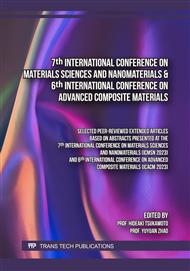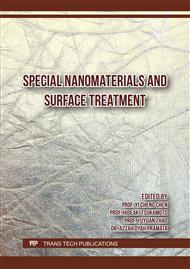[1]
M. Nguyen-Truong, Y. Li y Z. Wang, Mechanical Considerations of Electrospun Scaffolds for Myocardial Tissue and Regenerative Engineering, Bioengineering, vol. 7, p.122, October 2020.
DOI: 10.3390/bioengineering7040122
Google Scholar
[2]
B. W. Walker, R. P. Lara, C. H. Yu, E. S. Sani, W. Kimball, S. Joyce y N. Annabi, Engineering a naturally-derived adhesive and conductive cardiopatch, Biomaterials, vol. 207, p.89–101, July 2019.
DOI: 10.1016/j.biomaterials.2019.03.015
Google Scholar
[3]
J. M. Gomes, S. S. Silva y R. L. Reis, Biocompatible ionic liquids: fundamental behaviours and applications, Chemical Society Reviews, vol. 48, p.4317–4335, 2019.
DOI: 10.1039/c9cs00016j
Google Scholar
[4]
B. L. Rao, M. Gowda, S. Asha, K. Byrappa, B. Narayana, R. Somashekar, Y. Wang, L. N. Madhu y Y. Sangappa, Rapid synthesis of gold nanoparticles using silk fibroin: characterization, antibacterial activity, and anticancer properties, Gold Bulletin, vol. 50, p.289–297, August 2017.
DOI: 10.1007/s13404-017-0218-8
Google Scholar
[5]
H. Hwang, T. G. McCaslin, A. Hazel, C. V. Pagba, C. M. Nevin, A. Pavlova, B. A. Barry y J. C. Gumbart, Redox-Driven Conformational Dynamics in a Photosystem-II-Inspired b-Hairpin Maquette Determined through Spectroscopy and Simulation, The Journal of Physical Chemistry B, vol. 121, p.3536–3545, February 2017.
DOI: 10.1021/acs.jpcb.6b09481
Google Scholar
[6]
L. Feng, H. Yang, X. Dong, H. Lei y D. Chen, pH-sensitive polymeric particles as smart carriers for rebar inhibitors delivery in alkaline condition, Journal of Applied Polymer Science, vol. 135, p.45886, October 2017.
DOI: 10.1002/app.45886
Google Scholar
[7]
K. Mulia, E. Krisanti, F. Terahadi y S. Putri, Selected Natural Deep Eutectic Solvents for the Extraction of a-Mangostin from Mangosteen (Garcinia mangostana L.) Pericarp, International Journal of Technology, vol. 6, p.1211, December 2015.
DOI: 10.14716/ijtech.v6i7.1984
Google Scholar
[8]
M. Pourhossein, O. R. Heravizadeh, F. Omidi, M. Khadem y S. J. Shahtaheri, Ultrasound-Assisted Emulsified Microextraction Based on Deep Eutectic Solvent for Trace Residue Analysis of Metribuzin in Urine Samples, Methods and Objects of Chemical Analysis, vol. 16, p.153–161, 2021.
DOI: 10.17721/moca.2021.153-161
Google Scholar
[9]
X. Hu, D. Kaplan y P. Cebe, Determining Beta-Sheet Crystallinity in Fibrous Proteins by Thermal Analysis and Infrared Spectroscopy, Macromolecules, vol. 39, p.6161–6170, August 2006.
DOI: 10.1021/ma0610109
Google Scholar
[10]
H.-J. Jin, S. V. Fridrikh, G. C. Rutledge y D. L. Kaplan, Electrospinning Bombyx mori silk with poly(ethylene oxide), Biomacromolecules, vol. 3, p.1233–1239, August 2002.
DOI: 10.1021/bm025581u
Google Scholar
[11]
Y. Huang, K. Bailey, S. Wang y X. Feng, Silk fibroin films for potential applications in controlled release, Reactive and Functional Polymers, vol. 116, p.57–68, July 2017.
DOI: 10.1016/j.reactfunctpolym.2017.05.007
Google Scholar
[12]
J. Chutipakdeevong, U. R. Ruktanonchai y P. Supaphol, Process optimization of electrospun silk fibroin fiber mat for accelerated wound healing, Journal of Applied Polymer Science, vol. 130, p.3634–3644, June 2013.
DOI: 10.1002/app.39611
Google Scholar



